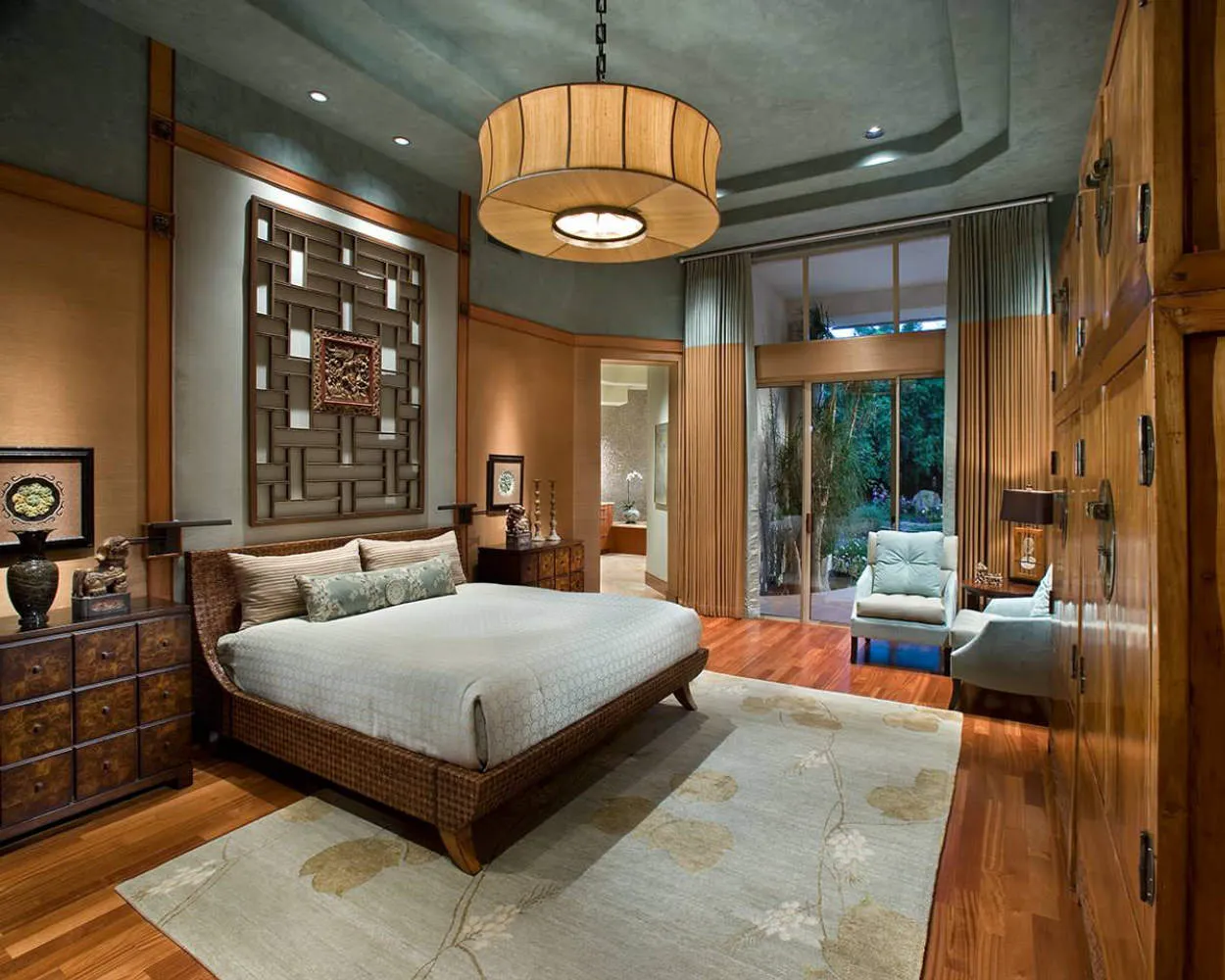Creating a zen bedroom is a key step towards embracing a calm and mindful lifestyle. This article explores the principles of zen design, highlighting key elements such as minimalism, natural materials, and soft lighting. Discover how to transform your bedroom into a serene sanctuary for relaxation and rejuvenation.
Fundamentals of Zen Design
In today’s fast-paced and chaotic world, achieving a sense of calm and mindfulness is often a challenge. One effective way to create a peaceful sanctuary is by incorporating Zen design principles into your bedroom. Zen bedrooms are designed to promote relaxation, tranquility, and a sense of well-being.
Simplicity and Minimalism
Central to Zen design is the concept of simplicity and minimalism. Keep the room clutter-free and only include essential furniture and accessories. Choose a neutral color palette, such as whites, beiges, and subtle earth tones, to create a serene atmosphere.
Natural Materials
Integrating natural materials into your bedroom will further enhance the Zen ambiance. Opt for wooden flooring, bamboo blinds, and natural fabrics for curtains and bedding. Incorporate elements like rocks, plants, or a small indoor water feature to bring a sense of nature indoors.
Balance and Harmony
Achieving balance and harmony in your Zen bedroom is essential. Position furniture and decor symmetrically and create a sense of equilibrium. Implementing feng shui principles can also help maximize positive energy flow and create a harmonious space.
Soft Lighting and Tranquil Colors
Soft, diffused lighting is crucial for creating a calming atmosphere. Use warm, gentle light sources, such as dimmable lamps or candles, and avoid harsh, bright overhead lighting. Consider adding a salt lamp for its soothing glow. Additionally, choose colors that evoke tranquility, such as soft blues, greens, and lavender shades.
Mindful Arrangement
When arranging furniture, adopt a mindful approach. Place your bed in a position that allows you to see the entrance, as this promotes a sense of security. Remove electronic devices or keep them out of sight to minimize distractions and foster relaxation.
Creating a Clutter-Free Environment
A cluttered space can hinder relaxation and mindfulness. Implement effective storage solutions to keep your belongings organized and out of sight. Adopt a minimalist mindset when it comes to decorating, ensuring that every item serves a purpose and enhances the calming atmosphere.
Conclusion
Incorporating Zen design principles into your bedroom can have a profound impact on your overall well-being. By keeping the space simple, using natural materials, achieving balance and harmony, and implementing soft lighting, you can create a tranquil sanctuary that promotes relaxation and mindfulness.
Minimalist Bedroom Approaches
A minimalist bedroom is all about creating a calm and peaceful space that promotes relaxation and mindfulness. By focusing on simplicity and clean lines, a minimalist design can help declutter the mind and enhance overall well-being. Here are some essential approaches to consider when designing a Zen-inspired bedroom:
Neutral Color Palette
Choose a neutral color scheme for the walls, furniture, and bedding. Shades of white, beige, or light gray can create a serene atmosphere and visually expand the space. Avoid loud and bold colors that can be distracting.
Clutter-Free Environment
Keep the bedroom decluttered and remove any unnecessary items. Embrace the “less is more” philosophy by only including essential furniture and decor. Storage solutions such as minimalist wardrobes and hidden shelves can help maintain a tidy space.
Natural Elements
Incorporate natural elements into the bedroom decor. Use materials like wood, bamboo, or rattan to add warmth and a sense of nature. Adding indoor plants can also improve air quality and create a soothing ambiance.
Soothing Lighting
Opt for soft and warm lighting options in the bedroom. Avoid harsh and bright lights that can be disruptive to a peaceful atmosphere. Use dimmers and layer different light sources to create a cozy and relaxing environment.
Comfortable Bedding
Invest in high-quality bedding that promotes comfort and relaxation. Opt for breathable fabrics like cotton or linen. Keep the bed simple and uncluttered with minimal pillows and accessories for a clean and peaceful look.
Natural Elements in Zen Spaces
Zen bedrooms are designed to create a space of mindfulness and calm. One key element that contributes to the serene atmosphere is the incorporation of natural elements. These elements not only enhance the visual aesthetics but also promote a sense of harmony and tranquility.
One natural element commonly found in Zen bedrooms is wood. The use of wooden furniture, flooring, and accessories brings warmth and a sense of nature into the space. The natural grains and textures of wood create a calming effect, helping to establish a connection with the surrounding environment.
Another essential natural element is light. Zen bedrooms often prioritize natural light, allowing it to flow freely into the space. Large windows, sheer curtains, and skylights are commonly used to maximize the entry of daylight. Natural light not only illuminates the room but also provides a sense of openness and connection to the outside world.
Additionally, incorporating plants and greenery is a popular way to introduce nature into a Zen bedroom. Indoor plants not only add a touch of freshness and beauty but also improve air quality and create a soothing ambiance. The presence of plants brings a sense of life and vitality, contributing to the calming and rejuvenating atmosphere.
In conclusion, natural elements play a vital role in creating Zen bedrooms that promote mindfulness and calmness. By incorporating wood, natural light, and plants, these spaces offer a harmonious environment that allows individuals to find peace and tranquility.
Color Schemes for Serenity
In the world of interior design, color plays a crucial role in creating a peaceful and calming atmosphere. When it comes to designing zen bedrooms that promote mindfulness and tranquility, choosing the right color schemes is essential. Here are some recommended color palettes to achieve serenity in your bedroom:
1. Neutral Colors
Neutral colors such as white, beige, and gray are timeless choices for creating a serene bedroom. These hues have a calming effect on the mind and can make the space feel open and peaceful. Opt for soft shades of these neutral tones to create a soothing ambiance.
2. Cool Blues
Blue is known for its calming properties and is often associated with serenity and tranquility. Light shades of blue, such as sky blue, baby blue, or aqua, can evoke a sense of relaxation and peace in a bedroom. Combine different tones of blue to create a harmonious and calming atmosphere.
3. Earthy Tones
Bringing elements of nature into the bedroom can also contribute to a zen-like ambiance. Earthy tones, such as sandy beige, soft greens, and warm browns, can create a connection to the outdoors and evoke a peaceful environment. These colors can be incorporated through furniture, accessories, or even wall paint.
4. Pastel Pinks
Soothing and gentle, pastel pinks can create a serene and feminine atmosphere in a zen bedroom. This color can help promote relaxation and emotional balance. Soft shades of pink, such as blush or dusty rose, can be used as accent colors or applied to larger areas to create a calming effect.
In conclusion, selecting the right color scheme is crucial when designing a zen bedroom for mindfulness and calm. Neutral colors, cool blues, earthy tones, and pastel pinks are all great options to create a serene ambiance. Consider integrating these colors into your bedroom design to enhance tranquility and promote a peaceful state of mind.
Creating a Meditative Space
In the busy and chaotic world we live in, it’s essential to have a space in our homes where we can unwind, relax, and find peace. A meditative space, also known as a Zen bedroom, provides the ideal environment for mindfulness and calm. Here are some key elements to consider when designing your own Zen bedroom:
Simplicity and Minimalism
A Zen bedroom should be free from clutter and unnecessary distractions. Simplify your space by removing any unnecessary furniture or decor. Keep only the essentials and embrace minimalism to create a serene and peaceful atmosphere.
Natural Elements
Incorporate natural elements into your Zen bedroom to connect with nature and promote relaxation. Use materials such as wood, bamboo, and stone. Add plants or a small indoor garden to bring a sense of tranquility and freshness.
Soft Lighting
Avoid harsh, bright lights in your Zen bedroom. Opt for soft, warm lighting that creates a soothing ambiance. Consider using candles, floor lamps with dimmers, or string lights to achieve a gentle and calming glow.
Neutral Color Palette
Choose a neutral color palette for your Zen bedroom to promote a sense of harmony and balance. Use calming colors such as soft blues, pale greens, or muted earth tones. These colors will help create a serene atmosphere conducive to relaxation.
Comfortable Seating
Incorporate a comfortable seating area in your Zen bedroom where you can sit and meditate or simply unwind. Add floor cushions or a cozy armchair to create a designated space for reflection and contemplation.
Mindful Decor
Choose decor items that have a meaningful and calming effect on you. Display artwork or objects that inspire peace and tranquility. Avoid excessive ornamentation and instead select a few carefully chosen pieces that hold personal significance.
In conclusion, designing a Zen bedroom or meditative space is all about creating an environment that promotes mindfulness and calm. By incorporating simplicity, natural elements, soft lighting, a neutral color palette, comfortable seating, and mindful decor, you can transform your bedroom into a sanctuary of relaxation and peace.
Conclusion
In conclusion, creating a Zen bedroom is an excellent way to design a space that promotes mindfulness and calm. By incorporating minimalist furniture, soothing colors, natural materials, and clutter-free environments, individuals can create an oasis of tranquility and promote a sense of peace and serenity in their daily lives.




